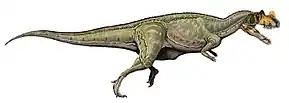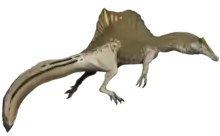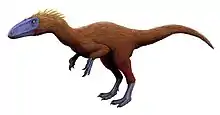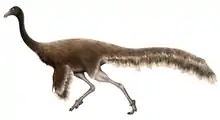Zhuchengtyrannus
Zhuchengtyrannus (meaning "Zhucheng tyrant") is a genus of tyrannosaurid theropod dinosaur known from the Campanian stage of the Late Cretaceous of Shandong Province, China. It belongs to the tyrannosaurinae subfamily, and contains a single species, Zhuchengtyrannus magnus.
| Zhuchengtyrannus | |
|---|---|
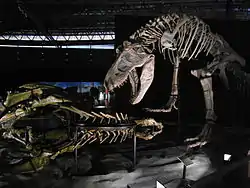 | |
| Reconstructed skeleton, with missing bones cast from Tyrannosaurus | |
| Scientific classification | |
| Kingdom: | Animalia |
| Phylum: | Chordata |
| Clade: | Dinosauria |
| Clade: | Saurischia |
| Clade: | Theropoda |
| Family: | †Tyrannosauridae |
| Subfamily: | †Tyrannosaurinae |
| Genus: | †Zhuchengtyrannus Hone et al., 2011 |
| Type species | |
| †Zhuchengtyrannus magnus Hone et al., 2011 | |
| Synonyms | |
| |
Discovery and naming
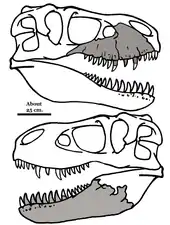
Zhuchengtyrannus was first described and named by David W. E. Hone, Kebai Wang, Corwin Sullivan, Xijin Zhao, Shuqing Chen, Dunjin Li, Shuan Ji, Qiang Ji and Xing Xu in 2011 and the type species is Zhuchengtyrannus magnus. The generic name is derived from the word Zhucheng, which refers to the type locality, and tyrant in reference to its phylogenetic position as a tyrannosaurid. The specific name magnus meaning "great" in Latin refers to the relatively large size of Zhuchengtyrannus.[1]
Zhuchengtyrannus is known solely from the holotype ZCDM V0031, a nearly complete right maxilla and associated left dentary (lower jaw, both with teeth) housed at Zhucheng Dinosaur Museum. Casts of the holotype, IVPP FV 1794, are held at the Institute of Vertebrate Paleontology and Paleoanthropology. ZCDM V0031 was collected in the Xingezhuang Formation from the Wangshi Group at Zangjiazhuang quarry, Zhucheng City, dating to the Campanian stage, at least 73.5 million years ago. A second tyrannosaurid dentary (ZCDM V0030) and maxilla (ZCDM V0032) have also been collected at Zangjiazhuang quarry. Even though they were not associated with one another, both specimens are different from other tyrannosaurids, including Zhuchengtyrannus, implying the existence of at least one additional tyrannosaurid from the quarry. Apart from the tyrannosaurid material, specimens of Sinoceratops, hadrosaurids (probably Shantungosaurus) and ankylosaurs were recovered from it.[1] Zhuchengtyrannus was found in an area that was a floodplain in the Cretaceous period and contains one of the highest concentrations of dinosaur bones in the world.[2]
Description

Zhuchengtyrannus was a large carnivorous theropod, and the holotype has been estimated to have been 10–12 m (33–39 ft) in length and up to 6 short tons (5.4 t) in weight. The holotype dentary is slightly smaller than that of most specimens of Tyrannosaurus rex and slightly bigger than most of Tarbosaurus bataar,[1] but significantly smaller than the corresponding bones of one of the largest Tyrannosaurus specimens ("Sue").[3] In 2016 Molina-Pérez and Larramendi estimated the (ZCDM V0030) specimen at 9.6 meters (31.5 feet) long, 2.9 meters (9.5 feet) tall at the hips and 4 tonnes (4.4 short tons) in weight.[4]
Zhuchengtyrannus can be distinguished from all other tyrannosaurines by a single autapomorphy, the presence of a horizontal shelf on the lateral surface of the base of the ascending process of the maxilla, and a rounded notch in the anterior margin of the maxillary fenestra. Zhuchengtyrannus also possesses a ventral margin of the antorbital fenestra that lies well above that of the ventral rim of the antorbital fossa. Additionally, the total length of the maxillary fenestra is more than half the distance between the anterior margins of the antorbital fossa and fenestra. Unlike the contemporaneous Tarbosaurus, Zhuchengtyrannus lacks a subcutaneous flange on the posterodorsal part of the jugal ramus of the maxilla, and a ventrally convex palatal shelf that covers the bulges of the roots of the rear teeth in medial view.[1]
Classification

It is possible that several isolated teeth from one of the Zhucheng dinosaur quarries, previously given the name Tyrannosaurus zhuchengensis, belong to this or a related species. The T. zhuchengensis teeth are characterized by serrations that extend all the way to the base of the tooth crown, a feature not seen in any other tyrannosaurine species. All known teeth of Zhuchengtyrannus are too poorly preserved in this area to compare with T. zhuchengensis, but further finds may clarify their relationship.[1]
A phylogenetic analysis published with the description of the tyrannosaurine Lythronax in the journal PLOS One by Loewen et al. 2013, recovered Zhuchengtyrannus as the sister taxon of Tarbosaurus. It also suggests that Zhuchengtyrannus and other currently known Asian tyrannosaurids were part of an evolutionary radiation descending from the same North American stem that later gave rise to Tyrannosaurus, recovered as their closest known relative. Below are the results obtained in their phylogenetic analysis:[5]
.jpg.webp)
| Tyrannosauridae |
| ||||||||||||||||||||||||||||||||||||||||||||||||||||||||||||
See also
| Wikimedia Commons has media related to Zhuchengtyrannus. |
References
- Hone, D. W. E.; Wang, K.; Sullivan, C.; Zhao, X.; Chen, S.; Li, D.; Ji, S.; Ji, Q.; Xu, X. (2011). "A new, large tyrannosaurine theropod from the Upper Cretaceous of China". Cretaceous Research. 32 (4): 495–503. doi:10.1016/j.cretres.2011.03.005.
- "New dino in same league as T. rex". The Sydney Morning Herald. 1 April 2011. Retrieved 3 April 2011.
- Hone D, "So just how big was Zhuchengtyrannus?", archosaurmusings.wordpress.com, 3-4-2011.
- Molina-Pérez & Larramendi (2016). Récords y curiosidades de los dinosaurios Terópodos y otros dinosauromorfos. Barcelona, Spain: Larousse. p. 267. ISBN 9780565094973.
- Loewen, M. A.; Irmis, R. B.; Sertich, J. J. W.; Currie, P. J.; Sampson, S. D. (2013). Evans, D. C. (ed.). "Tyrant Dinosaur Evolution Tracks the Rise and Fall of Late Cretaceous Oceans". PLOS ONE. 8 (11): e79420. Bibcode:2013PLoSO...879420L. doi:10.1371/journal.pone.0079420. PMC 3819173. PMID 24223179.

